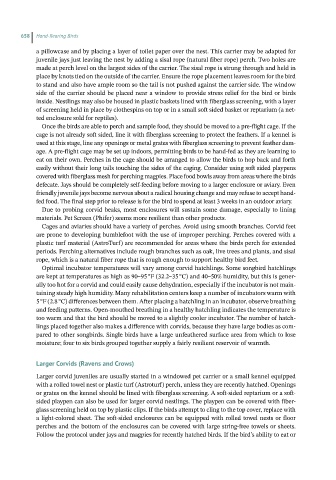Page 657 - Hand rearing birds second
P. 657
658 Hand-Rearing Birds
a pillowcase and by placing a layer of toilet paper over the nest. This carrier may be adapted for
juvenile jays just leaving the nest by adding a sisal rope (natural fiber rope) perch. Two holes are
made at perch level on the largest sides of the carrier. The sisal rope is strung through and held in
place by knots tied on the outside of the carrier. Ensure the rope placement leaves room for the bird
to stand and also have ample room so the tail is not pushed against the carrier side. The window
side of the carrier should be placed near a window to provide stress relief for the bird or birds
inside. Nestlings may also be housed in plastic baskets lined with fiberglass screening, with a layer
of screening held in place by clothespins on top or in a small soft sided basket or reptarium (a net-
ted enclosure sold for reptiles).
Once the birds are able to perch and sample food, they should be moved to a pre-flight cage. If the
cage is not already soft sided, line it with fiberglass screening to protect the feathers. If a kennel is
used at this stage, line any openings or metal grates with fiberglass screening to prevent feather dam-
age. A pre-flight cage may be set up indoors, permitting birds to be hand-fed as they are learning to
eat on their own. Perches in the cage should be arranged to allow the birds to hop back and forth
easily without their long tails touching the sides of the caging. Consider using soft sided playpens
covered with fiberglass mesh for perching magpies. Place food bowls away from areas where the birds
defecate. Jays should be completely self-feeding before moving to a larger enclosure or aviary. Even
friendly juvenile jays become nervous about a radical housing change and may refuse to accept hand-
fed food. The final step prior to release is for the bird to spend at least 3 weeks in an outdoor aviary.
Due to probing corvid beaks, most enclosures will sustain some damage, especially to lining
materials. Pet Screen (Phifer) seems more resilient than other products.
Cages and aviaries should have a variety of perches. Avoid using smooth branches. Corvid feet
are prone to developing bumblefoot with the use of improper perching. Perches covered with a
plastic turf material (AstroTurf) are recommended for areas where the birds perch for extended
periods. Perching alternatives include rough branches such as oak, live trees and plants, and sisal
rope, which is a natural fiber rope that is rough enough to support healthy bird feet.
Optimal incubator temperatures will vary among corvid hatchlings. Some songbird hatchlings
are kept at temperatures as high as 90–95 °F (32.2–35 °C) and 40–50% humidity, but this is gener-
ally too hot for a corvid and could easily cause dehydration, especially if the incubator is not main-
taining steady high humidity. Many rehabilitation centers keep a number of incubators warm with
5 °F (2.8 °C) differences between them. After placing a hatchling in an incubator, observe breathing
and feeding patterns. Open-mouthed breathing in a healthy hatchling indicates the temperature is
too warm and that the bird should be moved to a slightly cooler incubator. The number of hatch-
lings placed together also makes a difference with corvids, because they have large bodies as com-
pared to other songbirds. Single birds have a large unfeathered surface area from which to lose
moisture; four to six birds grouped together supply a fairly resilient reservoir of warmth.
LargerCorvids(Ravensand Crows)
Larger corvid juveniles are usually started in a windowed pet carrier or a small kennel equipped
with a rolled towel nest or plastic turf (Astroturf) perch, unless they are recently hatched. Openings
or grates on the kennel should be lined with fiberglass screening. A soft-sided reptarium or a soft-
sided playpen can also be used for larger corvid nestlings. The playpen can be covered with fiber-
glass screening held on top by plastic clips. If the birds attempt to cling to the top cover, replace with
a light-colored sheet. The soft-sided enclosures can be equipped with rolled towel nests or floor
perches and the bottom of the enclosures can be covered with large string-free towels or sheets.
Follow the protocol under jays and magpies for recently hatched birds. If the bird’s ability to eat or

